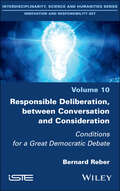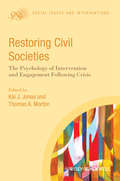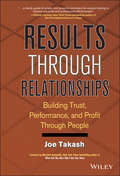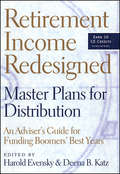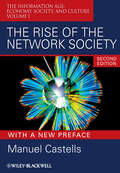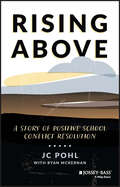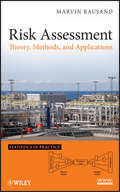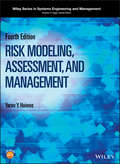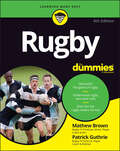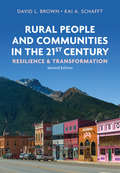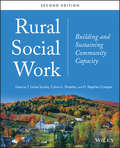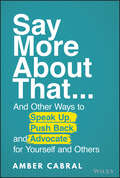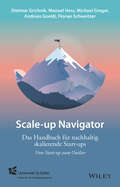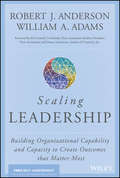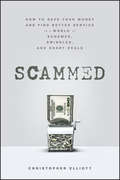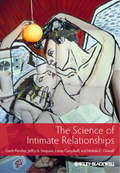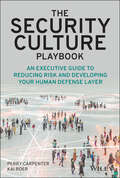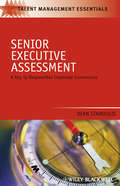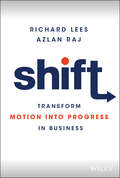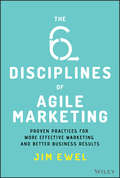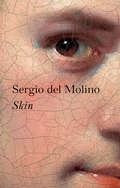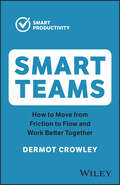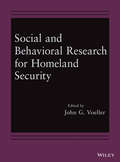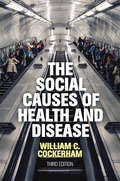- Table View
- List View
Responsible Deliberation, between Conversation and Consideration: Conditions for a Great Democratic Debate
by Bernard ReberCommunication is a crucial issue in our complex societies tinted by distrust. It is the core of democratic life and almost all human and social actions. Therefore it is essential for communication to be responsible. But responsible communication cannot only be conceived as a deontological issue, framed by ethical compliance requirements or good practices promotion. It should be considered with all the virtualities of communication, from conversation to consideration, going through narrative, interpretation and argumentation. Indeed each of these communicational capacities has its properties, assets, complementarities and limitations. They constitute different ways to be responsive. This book offers a contribution to the debate of Theory of Deliberative Theory (TDD), reexamined here within its different inspiration sources, notably the opposition between communicational turn and system, the fact of moral pluralism and the public reason.
Restoring Civil Societies: The Psychology of Intervention and Engagement Following Crisis (Contemporary Social Issues #11)
by Kai J. Jonas Thomas A. MortonBreakdowns in civil societies can be catalyzed by factors ranging from war and genocide to natural disaster, disease and economic downturns. Restoring Civil Societies examines social processes related to civic engagement in the wake of these societal ruptures. The authors show how crises in civil society can be both pervasive and localized, broad-based and limited to defined social sub-groups. Whatever their scale, Restoring Civil Societies identifies models that analyze the social psychology of crises in order to devise ways of re-activating civic engagement and safeguarding civil society. Focusing on these positive interventions, the authors identify a number of key strategies, ranging from the simplicity and directness of bystander interventions to the volunteer armies mobilized in the wake of natural disasters. They include collective action organized to redress systemic inequalities, and the vital healing role played by truth commissions in Rwanda and elsewhere. Restoring Civil Societies fills the gap between basic research on social issues and translation into social policies and programs-an area which, in light of current economic and social unrest, is more important now than ever.
Results Through Relationships
by Joe TakashA career guide to more significant business results in a shorter period of timeResults Through Relationships shows professionals how to establish break-through relationships with new prospects and their existing networks, including colleagues, bosses, customers, clients, vendors, and others. Many people assume that only new contacts will help them achieve their goals, but in reality, many breakthroughs happen within existing networks. This handy career guide focuses on the bottom-line behaviors that expedite trust, improve workplace performance, and increase profit. Author Joe Takash presents a nine-step process that anyone can master, and his formula proves that we're all in the relationship business first.
Retirement Income Redesigned: Master Plans for Distribution -- An Adviser's Guide for Funding Boomers' Best Years
by Harold Evensky Katz Deena B. Walter UpdegraveClients nearing retirement have some significant challenges to face. And so do their advisers. They can expect to live far longer after they retire. And the problems they expect their advisers to solve are far more complex. The traditional sources of retirement income may be shriveling, but boomers don't intend to downsize their plans. Instead, they're redefining what it means to be retired--as well as what they require of financial advisers. Planners who aren't prepared will be left behind. Those who are will step up to some lucrative and challenging work. To help get the work done, Harold Evensky and Deena Katz--both veteran problem solvers--have tapped the talents of a range of experts whose breakthrough thinking offers solutions to even the thorniest issues in retirement-income planning: Sustainable withdrawals Longevity risk Eliminating luck as a factor in planning Immediate annuities, reverse mortgages, and viatical and life settlements Strategies for increasing retirement cash flow In Retirement Income Redesigned, the most-respected names in the industry discuss these issues and a range of others.
The Rise of the Network Society: The Information Age: Economy, Society And Culture, Volume I (Information Age Series #12)
by Manuel CastellsThis first book in Castells' groundbreaking trilogy, with a substantial new preface, highlights the economic and social dynamics of the information age and shows how the network society has now fully risen on a global scale. Groundbreaking volume on the impact of the age of information on all aspects of society Includes coverage of the influence of the internet and the net-economy Describes the accelerating pace of innovation and social transformation Based on research in the USA, Asia, Latin America, and Europe
Rising Above: A Story of Positive School Conflict Resolution
by J. C. Pohl Ryan McKernanTransform your school’s culture for the better In Rising Above, we meet Serenity Springs High School’s new school counselor Monica Sheppard as she is fielding a barrage of school conflict issues coming at her from what seems like every direction. Backed by a team of veteran school culture experts from different facets of education, author JC Pohl delivers an engaging, ripped-from-the-headlines narrative about a fictional school community devolving into chaos. With social media running out of control, teachers feeling burnt out, and a principal that has simply lost her way, Monica immerses herself into the school community and strives to bridge many of the divides that define contemporary school environments across the United States. The book includes insights from real-world experts, including Principal Dr. Pete Getz, relationship expert Emil Harker, LMFT, and school counselor educator Dr. Stephanie Eberts. It also offers: A comprehensive set of strategies and tools to help cure the ailments destroying school culture Insightful discussions of teacher-student, teacher-teacher, teacher-administration, teacher-parent, teacher-staff, and student-student conflict management and resolution A compelling narrative of a school leader rising above the chaos that surrounds her and showing readers a tangible pathway that leads to positive school conflict resolutionAn engrossing and essential read for principals, assistant principals, school counselors, and other district administrators, Rising Above also proves invaluable to K-12 teachers and higher education professors with an interest in building exemplary school cultures.
Risk Assessment
by Marvin RausandAn introduction to risk assessment that utilizes key theory and state-of-the-art applications With its balanced coverage of theory and applications along with standards and regulations, Risk Assessment: Theory, Methods, and Applications serves as a comprehensive introduction to the topic. The book serves as a practical guide to current risk analysis and risk assessment, emphasizing the possibility of sudden, major accidents across various areas of practice from machinery and manufacturing processes to nuclear power plants and transportation systems.The author applies a uniform framework to the discussion of each method, setting forth clear objectives and descriptions, while also shedding light on applications, essential resources, and advantages and disadvantages. Following an introduction that provides an overview of risk assessment, the book is organized into two sections that outline key theory, methods, and applications.Introduction to Risk Assessment defines key concepts and details the steps of a thorough risk assessment along with the necessary quantitative risk measures. Chapters outline the overall risk assessment process, and a discussion of accident models and accident causation offers readers new insights into how and why accidents occur to help them make better assessments.Risk Assessment Methods and Applications carefully describes the most relevant methods for risk assessment, including preliminary hazard analysis, HAZOP, fault tree analysis, and event tree analysis. Here, each method is accompanied by a self-contained description as well as workflow diagrams and worksheets that illustrate the use of discussed techniques. Important problem areas in risk assessment, such as barriers and barrier analysis, human errors, and human reliability, are discussed along with uncertainty and sensitivity analysis.Each chapter concludes with a listing of resources for further study of the topic, and detailed appendices outline main results from probability and statistics, related formulas, and a listing of key terms used in risk assessment. A related website features problems that allow readers to test their comprehension of the presented material and supplemental slides to facilitate the learning process.Risk Assessment is an excellent book for courses on risk analysis and risk assessment at the upper-undergraduate and graduate levels. It also serves as a valuable reference for engineers, researchers, consultants, and practitioners who use risk assessment techniques in their everyday work.
Risk Modeling, Assessment, and Management
by Yacov Y. HaimesExamines timely multidisciplinary applications, problems, and case histories in risk modeling, assessment, and managementRisk Modeling, Assessment, and Management, Third Edition describes the state of the art of risk analysis, a rapidly growing field with important applications in engineering, science, manufacturing, business, homeland security, management, and public policy. Unlike any other text on the subject, this definitive work applies the art and science of risk analysis to current and emergent engineering and socioeconomic problems. It clearly demonstrates how to quantify risk and construct probabilities for real-world decision-making problems, including a host of institutional, organizational, and political issues.Avoiding higher mathematics whenever possible, this important new edition presents basic concepts as well as advanced material. It incorporates numerous examples and case studies to illustrate the analytical methods under discussion and features restructured and updated chapters, as well as:A new chapter applying systems-driven and risk-based analysis to a variety of Homeland Security issuesAn accompanying FTP site--developed with Professor Joost Santos--that offers 150 example problems with an Instructor's Solution Manual and case studies from a variety of journalsCase studies on the 9/11 attack and Hurricane KatrinaAn adaptive multiplayer Hierarchical Holographic Modeling (HHM) game added to Chapter ThreeThis is an indispensable resource for academic, industry, and government professionals in such diverse areas as homeland and cyber security, healthcare, the environment, physical infrastructure systems, engineering, business, and more. It is also a valuable textbook for both undergraduate and graduate students in systems engineering and systems management courses with a focus on our uncertain world.
Rugby For Dummies
by Mathew Brown Patrick GuthrieRugby basics for fans, players, and parents who are new to the game, plus all the latest developments for those returning to the sport Rugby For Dummies, Fourth Edition teaches you the essential elements of the fast-growing sport of rugby, so you can follow all the action—and get ready for the U.S.-hosted 2031 and 2033 Rugby World Cups. This helpful Dummies guide also gives you the information that you need to start playing or coaching rugby. You’ll get clear explanations of the rules, insight into strategy and tactics, and info on all the most popular tournaments around the globe. Learn about the rugby greats of yesterday, plus get updates on the most significant changes at every level, from high school to international level. This new edition covers the evolution of the laws that govern play and looks at how the women’s game and the sevens version of the sport have grown. Learn how rugby is played, including necessary skills and strategies for winning Take a look at the most entertaining North American and international rugby competitions Get tips for joining a rugby team or becoming a rugby coach Familiarize yourself with the history of previous World Cups in time for the next oneThis is the perfect Dummies guide for anyone who wants to better understand all aspects of the game of rugby.
Rural People and Communities in the 21st Century: Resilience And Transformation
by David L. Brown Kai A. SchafftRural people and communities continue to play important social, economic and environmental roles at a time in which societies are rapidly urbanizing, and the identities of local places are increasingly subsumed by flows of people, information and economic activity across global spaces. <P><P>However, while the organization of rural life has been fundamentally transformed by institutional and social changes that have occurred since the mid-twentieth century, rural people and communities have proved resilient in the face of these transformations. <P><P>This book examines the causes and consequences of major social and economic changes affecting rural communities and populations during the first decades of the twenty-first century, and explores policies developed to ameliorate problems or enhance opportunities. Primarily focused on the U.S. context, while also providing international comparative discussion, the book is organized into five sections each of which explores both socio-demographic and political economic aspects of rural transformation. It features an accessible and up-to-date blend of theory and empirical analysis, with each chapter's discussion grounded in real-life situations through the use of empirical case-study materials. <P><P> Rural People and Communities in the 21st Century is intended for advanced undergraduate and graduate courses in rural sociology, community sociology, rural and/or population geography, community development, and population studies.
Rural Social Work
by H. Stephen Cooper Calvin L. Streeter T. Laine ScalesA thoughtful text integrating strengths, assets, and capacity-building themes with contemporary issues in rural social work practiceNow in its second edition, Rural Social Work is a collection of contributed readings from social work scholars, students, and practitioners presenting a framework for resource building based on the strengths, assets, and capacities of people, a tool essential for working with rural communities.This guide considers methods for social workers to participate in the work of sustaining rural communities. Each chapter features a reading integrating the themes of capacity-building and rural social work; discussion questions that facilitate critical thinking around the chapter; and suggested activities and assignments.Rural Social Work, Second Edition explores:Important practice issues in rural communities, including the challenges of working with stigmatized populations such as gay, lesbian, bisexual, and transgendered people, the homeless, and people living with HIV/AIDSPractice models that hold special promise for rural social workers, including evidence-based practice and community partnership modelsNewer research tools such as asset mapping, social network analysis, concept mapping, and Geographic Information Systems (GIS)Exploring how social workers can integrate the tremendous resources that exist in rural communities into their practice, Rural Social Work, Second Edition provides a solid introduction to the complex, challenging, and rewarding work of building and sustaining rural communities.
Say More About That: ...And Other Ways to Speak Up, Push Back, and Advocate for Yourself and Others
by Amber CabralConcrete strategies to call out wrongdoing at home, at work, at school, and elsewhere In Say More About That, veteran inclusion strategist, coach, writer, and speaker Amber Cabral delivers an incisive and practical guide to assertively addressing inequitable treatment you see at home, work, school, and other settings. The book offers a complete communications toolkit for equity advocacy you can deploy on your own behalf and on behalf of others. You&’ll get the tactics, context, and tools that make being brave and speaking up a lot easier. You&’ll also find: A thorough discussion of the fundamentals of inclusion and equity, including concepts of advocacy and allyship, privilege, and identity An examination of the social landscape that makes speaking up so daunting Explorations of the most effective language and tactics you can use when you make a stand for yourself or others The perfect resource for underrepresented professionals, allies, advocates, and people seeking to make a positive difference in the world, Say More About That is the assertiveness manual you need if you&’ve been meaning to speak up but are worried about being drowned out.
Scale-up-Navigator: Das Handbuch für nachhaltig skalierende Start-ups - vom Start-up zum Outlier
by Dietmar Grichnik Manuel Hess Michael Greger Andreas Goeldi Florian SchweitzerMit Case Studies von Scale-ups wie DeepL, SumUp, 1KOMMA5°, Frontify oder Ledgy! Europa hat mit seinen über 700 Millionen EinwohnerInnen einen großen Binnenmarkt, auf dem aber keine Technologieunternehmen vom Kaliber globaler Big Techs wie Apple, Alphabet/Google, Amazon, Meta/Facebook oder Microsoft gelistet sind. In der ersten Digitalisierungswelle des Internets genossen die USA durch ihren homogenen Heimatmarkt einen klaren Wachstumsvorteil. Dies mag sich durch maschinelle Übersetzungstools und weitere KI-unterstützte Lösungen ändern. Hierzu muss die Skalierung von europäischen Unternehmen erlernt werden. Sie ist eine entscheidende Fähigkeit in einem Spiel auf Zeit: Start-ups müssen wachsen, bevor ihre Konkurrenz aus anderen Start-ups oder etablierten Unternehmen an ihnen vorbeizieht. Dazu gilt es, den gestiegenen Anforderungen an die soziale und ökologische Nachhaltigkeit sowie Unternehmensführung (ESG) gerecht zu werden. Dieses Buch vermittelt Leitlinien für GründerInnen, Mitarbeitende, Investoren/Investorinnen, Mentoren/Mentorinnen und weitere Stakeholder von skalierenden Start-ups, sogenannten "Scale-ups", die sie beim schnellen und nachhaltigen Wachstum unterstützen. Sie entwickeln damit ein besseres Verständnis für verschiedenste Herausforderungen bei der Skalierung ihres Unternehmens und meistern diese besser, wie beispielsweise die Entwicklung und Führung ihres Teams, die Bewertung von Wachstums- und Finanzierungsoptionen sowie die Implementierung effizienter Organisationsstrukturen und Kommunikationsprozesse. Die LeserInnen profitieren konkret von: - einer Strukturierung der Skalierung, basierend auf einem iterativen Prozess-Framework; - einem durchgehenden Fokus auf für den Kapitalmarkt relevante ESG-Kriterien; - Handlungsempfehlungen inklusive digitaler Tools, welche sie bei der Skalierung ihrer Unternehmen unterstützen.
Scaling Leadership: Building Organizational Capability and Capacity to Create Outcomes that Matter Most
by Robert J. Anderson William A. Adams Ed CatmullTransform Your Organization by Scaling Leadership How do senior leaders, in their own words, describe the most effective leaders—the ones that get results, grow the business, enhance the culture and leave in their wake a trail of other really effective leaders? Conversely, how do senior leaders describe the kind of leader that undercuts the organization’s capacity and capability to create its future? This book, based on groundbreaking research, shows how senior leaders describe and develop leadership that works, that does not, that scales, and that limits scale. Is your leadership built for scale as you advance in today’s volatile, uncertain, dynamic, and disruptive business environment? This context puts a premium on a very particular kind of leadership—High-Creative leadership capable of rapidly growing the organization while simultaneously transforming it into more agile, innovative, adaptive and engaging workplace. The research presented in this book suggests that senior leaders can describe the High-Creative leadership with surprising clarity. They also describe with equal precision the High-Reactive leadership that cancels itself out and seriously limits scale. Which type of leader are you? You scale your leadership by increasing the multiple on your leadership in three ways. First, by developing the strengths that differentiate the most effective leaders from the strengths deployed by the most Reactive and ineffective leaders. And second, by increasing your leadership ratio—the ratio of most the effective strengths to the most damaging liabilities. Third, by developing High-Creative leaders all around you. Scaling Leadership provides a proven framework for magnifying agile and scalable leadership in your organization. Scalable leadership drives forward-momentum by multiplying high-achieving leaders at scale so that growth, productivity and innovation increase exponentially. Creative leaders multiply their strengths beyond technical competence by leading in deep relationship, with radical humanity, passion and integrity. Drawing upon decades of solid research and experience enhancing individual capability and collective leadership effectiveness with Fortune 500 companies and government agencies, the authors provide an innovative and efficient framework to help you: Take stock of your own personal balance of leadership strengths and weaknesses Scale your leadership in deep relationship and high integrity Proliferate high-achievers throughout your organization’s leadership system Identify ineffective leadership and course-correct quickly Transform your organization by transforming leadership Scaling Leadership is an invaluable tool for executives, managers, and leaders in business, academia, nonprofit organizations, and more. This innovative resource provides effective techniques, real-world examples, and expert guidance for organizations seeking to improve performance, align and execute strategies, and transform their business with scalable leadership capability.
Scammed: How to Save Your Money and Find Better Service in a World of Schemes, Swindles, and Shady Deals
by Christopher ElliottA leading consumer advocate reveals how to protect your money, time, and integrity from corrupt businesses Once upon a time store prices were simple and fair, businesses stood behind their products with guarantees free of fine print and loopholes, and companies genuinely seemed to care about their valued customers--but those days are long gone. In this groundbreaking exposé, consumer advocate Christopher Elliot reveals the broken relationship between American consumers and businesses and explains how companies came to believe that fooling their customers was a viable, and profitable, business plan. Scammed explores how companies control information to mislead, distort the truth, and even outright lie to their consumers. Exposes the various ways companies have led their war against information--from seductive ads, disingenuous fine print, and unconventional promotions that involve seeding discussion forums and blogs with company-friendly comments Offers consumers insider knowledge of the system, reasonable expectations, and a clear understanding of the games businesses play Christopher Elliott is one of the nation's foremost consumer advocates Protect yourself, your time, and your money from the predators of the consumer world. Armed with knowledge, readers will become far more discerning and every business's worst nightmare.
The Science of Intimate Relationships
by Lorne Campbell Jeffry A. Simpson Garth Fletcher Nickola OverallThe Science of Intimate Relationships represents the first interdisciplinary approach to the latest scientific findings relating to human sexual relationships.Offers an unusual degree of integration across topics, which include intimate relationships in terms of both mind and body; bonding from infancy to adulthood; selecting mates; love; communication and interaction; sex; passion; relationship dissolution; and moreSummarizes the links among human nature, culture, and intimate relationshipsPresents and integrates the latest findings in the fields of social psychology, evolutionary psychology, human sexuality, neuroscience and biology, developmental psychology, anthropology, and clinical psychology.Authored by four leading experts in the fieldInstructor materials are available at www.wiley.com/go/fletcher
The Security Culture Playbook: An Executive Guide To Reducing Risk and Developing Your Human Defense Layer
by Perry Carpenter Kai RoerMitigate human risk and bake security into your organization&’s culture from top to bottom with insights from leading experts in security awareness, behavior, and culture. The topic of security culture is mysterious and confusing to most leaders. But it doesn&’t have to be. In The Security Culture Playbook, Perry Carpenter and Kai Roer, two veteran cybersecurity strategists deliver experience-driven, actionable insights into how to transform your organization&’s security culture and reduce human risk at every level. This book exposes the gaps between how organizations have traditionally approached human risk and it provides security and business executives with the necessary information and tools needed to understand, measure, and improve facets of security culture across the organization. The book offers: An expose of what security culture really is and how it can be measured A careful exploration of the 7 dimensions that comprise security culture Practical tools for managing your security culture program, such as the Security Culture Framework and the Security Culture Maturity Model Insights into building support within the executive team and Board of Directors for your culture management programAlso including several revealing interviews from security culture thought leaders in a variety of industries, The Security Culture Playbook is an essential resource for cybersecurity professionals, risk and compliance managers, executives, board members, and other business leaders seeking to proactively manage and reduce risk.
Senior Executive Assessment
by Dean StamoulisSenior Executive Assessment is a concise and practical guide that demystifies assessment that is conducted at the senior-executive level. Defines Senior Executive Assessment, describes its benefits, and explains how it differs from assessment at lower levels Discusses how significant shifts in markets and business models can require a change in the characteristics needed in senior executives Provides a practical model with suggestions for assessing senior executives Offers guidelines for determining what assessment methods to use in an organization Examines practical considerations in how to choose professionals to conduct senior executive assessment
Shift: Transform Motion into Progress in Business
by Richard Lees Azlan RajUnderstand what’s required to deliver top-of-the-line customer experiences As organizations around the world do their best to deliver meaningful, effective, and efficient customer experiences, many are encountering difficulty translating their actions into progress. These businesses find that, despite a plethora of initiatives, programs, and plans, inclusive and excellent customer service remains stubbornly out of reach. In Shift: Transform Motion into Progress in Business, Chief Strategy and Marketing Officers at Merkle and dentsu offer business leaders a practical and coherent approach to creating the consistently exceptional customer experience that would set their business apart from the competition. The authors link three key themes—a clear vision with clear performance indicators, an aligned team, and a deep understanding of the marketplace—and outline their importance in the quest for the ideal client experience. They explain the importance of measuring progress through the eyes of the customer and ensuring that the measures that matter to customers are improving. A necessary addition to the reading lists of innovation and business development professionals, Shift deserves a place on the bookshelves of managers, executives, and other business leaders attempting to set their organization apart from the competition.
The Six Disciplines of Agile Marketing: Proven Practices for More Effective Marketing and Better Business Results
by Jim EwelTransform your organization using Agile principles with this proven framework The Six Disciplines of Agile Marketing provides a proven framework for applying Agile principles and processes to marketing. Written by celebrated consultant Jim Ewel, this book provides a concise, approachable, and adaptable strategy for the implementation of Agile in virtually any marketing organization. The Six Disciplines of Agile Marketing discusses six key areas of practical concern to the marketer who hopes to adopt Agile practices in their organization. They include: Aligning the team on common goals Structuring the team for greater efficiency Implementing processes like Scrum and Kanban in marketing Validated Learning Adapting to Change Creating Remarkable Customer Experiences The Six Disciplines of Agile Marketing also discusses four shifts in beliefs and behaviors necessary to achieving an Agile transformation in marketing organizations. They include: A shift from a focus on outputs to one based on outcomes A shift from a campaign mentality to one based on continuous improvement A shift from an internal focus to a customer focus <li style="margin: 0in 0
Skin
by Sergio del MolinoSkin is the border of our body and, as such, it is that through which we relate to others but also what separates us from them. Through skin, we speak: when we display it, when we tan it, when we tattoo it, or when we mute it by covering it with clothes. Skin exhibits social relationships, displays power and the effects of power, explains many things about who we are, how others perceive us and how we exist in the world. And when it gets sick, it turns us into monsters. In Skin, Sergio del Molino speaks of these monsters in history and literature, whose lives have been tormented by bad skin: Stalin secretly taking a bath in his dacha, Pablo Escobar getting up late and shutting himself in the shower, Cyndi Lauper performing a commercial for a medicine promising relief from skin disease, John Updike sunburned in the Caribbean, Nabokov writing to his wife from exile, ‘Everything would be fine, if it weren’t for the damned skin.’ As a psoriasis sufferer, Sergio del Molino includes himself in this gallery of monsters through whose stories he delves into the mysteries of skin. What is for some a badge of pride and for others a source of anguish and shame, skin speaks of us and for us when we don’t speak with words.
Smart Teams: How to Move from Friction to Flow and Work Better Together
by Dermot CrowleyLearn how your team can communicate, congregate and collaborate more effectively than ever Smart Teams will help your team to go beyond personal productivity to build a culture where productivity thrives. This book shows you how to turn around the unproductive team behaviours that create friction. You’ll learn the ‘superproductive’ behaviours that promote flow and the most impactful productivity principles for working better together. Smart Teams shares the practical guidelines and key skills you need to lead a productive, cooperative team. Email noise, unproductive meetings and poorly organised projects can stifle creativity and disrupt everyone’s workflow. A culture that isn’t productive results in long hours, more stress, and a lack of balance. But by raising awareness of how our behaviours impact our work and our colleagues, you build the desire and capability to change within your team. This book is packed with tips, guidelines and expert insights for leaders and managers at any level. Foster a culture of ‘superproductivity’ Create a set of Smart Team principles to guide cooperation Run fewer, shorter and more effective meetings Collaborate more productively on projects Reduce urgency, interruptions and email noise People want their work to matter, they want to make an impact and they want to do it all with a healthy work-life balance. Productivity is the key to making it all happen! Smart Teams shows you how to implement the culture shift that will allow your team to flourish. This book is part of the Smart Productivity series, helping readers find practical solutions for better managing their time, energy and focus.
Social and Behavioral Research for Homeland Security
by John G. VoellerSocial and Behavioral Research for Homeland Security features articles from the Wiley Handbook of Science and Technology for Homeland Security covering social and psychological aspects of terrorism and counterterrorism efforts from different perspectives. First, it examines the roots of terrorism; second, it explores the consequences of terrorism; then communication, training, and learning development of responders and the public in situations of terror attacks, are discussed.
Social Capital: A Comparative Analysis Of China, Taiwan And The Us (Key Concepts)
by Joonmo SonSocial capital is a principal concept across the social sciences and has readily entered into mainstream discourse. In short, it is popular. However, this popularity has taken its toll. Social capital suffers from a lack of consensus because of the varied ways it is measured, defined, and deployed by different researchers. It has been put to work in ways that stretch and confuse its conceptual value, blurring the lines between networks, trust, civic engagement, and any type of collaborative action. This clear and concise volume presents the diverse theoretical approaches of scholars from Marx, Coleman, and Bourdieu to Putnam, Fukuyama, and Lin, carefully analyzing their commonalities and differences. Joonmo Son categorizes this wealth of work according to whether its focus is on the necessary preconditions for social capital, its structural basis, or its production. He distinguishes between individual and collective social capital (from shared resources of a personal network to pooled assets of a whole society), and interrogates the practical impact social capital has had in various policy areas (from health to economic development). Social Capital will be of immense value to readers across the social sciences and practitioners in relevant fields seeking to understand this mercurial concept.
The Social Causes of Health and Disease
by William C. CockerhamThis stimulating book has become a go-to text for understanding the role that social factors play in the experience of health and many diseases. This extensively revised and updated third edition offers the most compelling case yet that stress, poverty, unhealthy lifestyles, and unpleasant living and working conditions can all be directly associated with illness. The book continues to build on the paradigm shift that has been emerging in twenty-first-century medical sociology, which looks beyond individual explanations for health and disease. As the field has headed toward a fundamentally different orientation, William Cockerham’s work has been at the forefront of these changes, and he here marshals evidence and theory for those seeking a clear and authoritative guide to the realities of the social determinants of health. Of particular note in the latest edition is new material on the relationship between gender and health, implications of the life course for health behavior, the health effects of social capital, and the emergence of COVID-19. This engaging introduction to social epidemiology will be indispensable reading for all students and scholars of medical sociology, especially those with the courage to confront the possibility that society really does make people sick.
